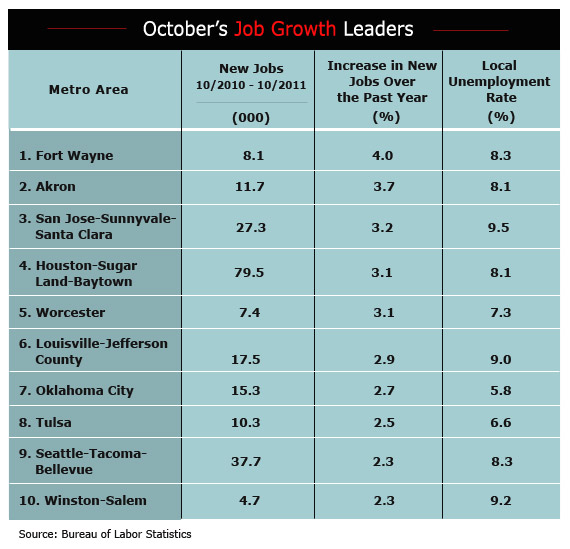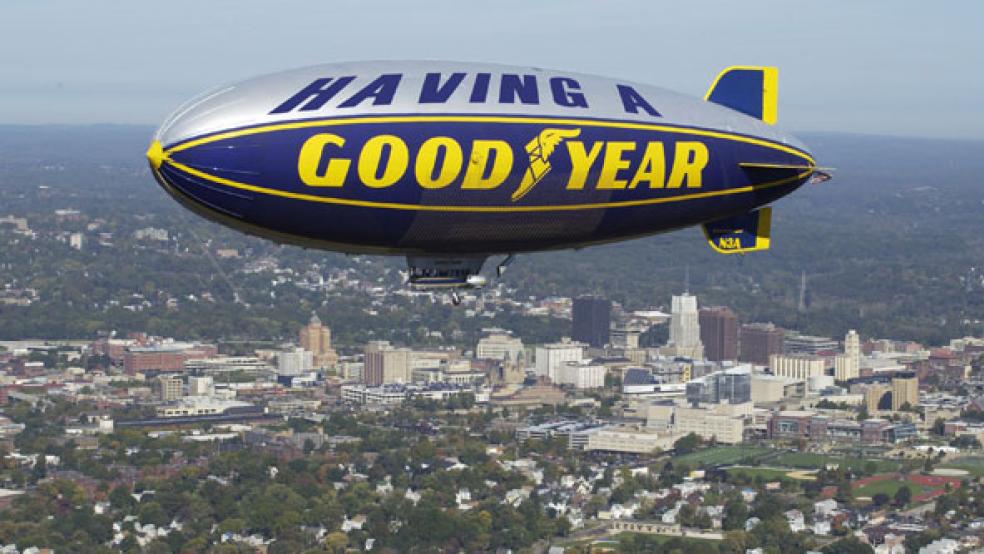From the rustbelt to the mid-South to Silicon Valley, the areas of the country that added jobs at the fastest pace during the past year have benefitted from a variety of factors, from the revitalization of the automobile industry to a surge in exports to the newest new things to emerge from the nation’s high-tech labs.
Of course, no area of the country is undergoing explosive growth, and even those that are doing better than most are cautious about the immediate outlook for their regions’ economies and jobs. “The view from our little corner of the world is that the economy is growing, but it’s not very fast and there’s considerable danger that it could start going in the other direction,” said Michael Nelson, chairman of the economics department at the University Akron. That city ranked second in October among metro areas in the rate of job growth year over year.
For the second month in a row, Fort Wayne stood atop the rankings as it continues to benefit from the rebirth of auto making and high levels of defense spending. Akron moved up seven notches to earn its second-place slot after a number of major companies that have historically called the city home recently recommitted to that part of Ohio, which is better known these days for being the birthplace of Lebron James than for its legacy as the tire capital of America.
Goodyear Tire & Rubber and Bridgestone/Firestone may no longer be making tires there, but they both built new research and technical centers in Akron during the past year. That led to a boost in construction jobs and several collateral expansions.
The city also has begun attracting foreign parts-manufacturers who want to be near Japanese and domestic automakers, which still build a large share of their vehicles in the Midwest. Röchling, a German plastics company that specializes in injection molding, just completed a $15 million facility that employs 125 skilled machinists. “You can still find machinists here because of the legacy of manufacturing in our area,” said a spokeswoman for the Greater Akron Chamber of Commerce.
“The growth here has primarily been in manufacturing,” said Nelson. “It seems like it’s a number of fairly small things that adds up to a year over year gain.” Other cities that made the top ten, such as Oklahoma City and Tulsa, also are benefiting from the mini-surge in manufacturing employment.
It is not surprising that California’s San Jose-Sunnyvale-Santa Clara metropolitan area – better known nationally as Silicon Valley – is the third-fastest growing metro area of the country. Apple’s latest iPad, Google’s continued dominance of Internet advertising and social media, especially Facebook, are driving growth. And it’s not just at those tech giants, but at numerous service providers and software developers that feed off innovation in the Valley.
“Things go in cycles,” said Douglas Henton, chief executive officer of Collaborative Economics, a consulting firm for civic entrepreneurs that closely tracks economic trends in the region. “This time it’s not so much the hardware side of things as the software side. Plus we’re seeing a boom in clean energy firms. There’s a lot happening right now.”
Still, the San Jose metro area and California as a whole still suffer from above-average unemployment rates – 9.5 percent in the San Jose area in October. “California lost 500,000 construction jobs,” Henton explained. “It’s all related to the collapse of the housing market, construction and finance.”
Another city moving up the rankings is Louisville, which was the sixth-fastest growing area year-over-year in job growth. Just a month ago, it ranked sixteenth. Louisville’s gains are partly about location: the diversified city is situated halfway along the I-65 corridor that stretches from Chicago to Atlanta and is sometimes called “auto alley,” since so many Japanese transplants and parts manufacturers have located along the route.
“A lot of what you’re seeing here is a product of our focus on advanced manufacturing; automotive is only a part of that,” said Eileen Pickett, executive vice president of Greater Louisville Inc., the local chamber of commerce. The metro area added 17,500 jobs in the past year to top the 600,000 mark, a level not reached since 2000-2001.
A good part of that expansion was fueled by the region’s major employers, which are reinvesting in their domestic manufacturing operations. Ford is retooling the local assembly plant to build the hybrid Escape, the successor to the popular Explorer SUV. The nation’s No. 2 automaker is in the process of adding 1,800 jobs because of the transition.
General Electric’s sprawling appliance park in Louisville, which hadn’t seen any investment in more than a decade and was even put up for sale three years ago when the company was desperately trying to raise capital during the financial crisis, is now moving in the other direction. In recent months, it’s announced retooling plans, hired 300 new workers, and announced it would hire 1,100 during the next three years. “This was a place that had not seen growth in a long time,” Pickett said.
Louisville is also benefiting by being home to UPS’s hub for air shipping products all over the globe. “Virtually every package that goes overseas winds up at Louisville’s airport before leaving for Europe or Asia,” said Barry Kornstein, research manager at the business college at the University of Louisville. “When the economy starts to get a little better and exports rise, all the warehouses that surround the airport start hiring.”
One example involves the Internet-based retailing company Zappos.com, which is now owned by Amazon. “They’ve built a gigantic warehouse here,” Kornstein said. It also has two fulfillment centers that added 1,300 workers in the past year. In August, the company announced plans to add 4,500 temporary employees in the Louisville area for the holiday season. For the folks in Louisville, that was very merry news indeed.





